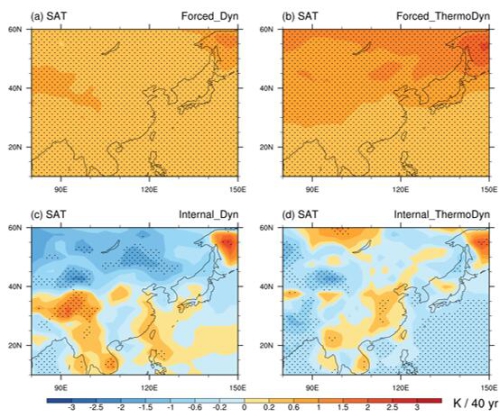Scientists Quantify Causes of East Asian Temperature Trends to Understand Future Warming
Date:2019-10-25
Detecting the causes of recent observed temperature trends is a major challenge, particularly at regional scales.
"That’s because the temperature trends vary on the multidecadal time-scale in response to its own internal variability as well as to the external forcings." Explained Prof. WANG Lin from Institute of Atmospheric Physics at Chinese Academy of Sciences. It remains challenging to quantify the contribution of internal and forced dynamic and thermodynamic components to the changes in the East Asian winter temperature in recent decades.
In a recently published study in Geophysical Research Letters, Wang’s team applied a "dynamical adjustment" methodology to estimate quantitatively the contribution of the internal and forced components to the East Asian winter temperature trends.
"We found that the internally generated variability offsets the forced warming by more than 70% in the northern East Asia (NEA), leading to a weak observed warming in NEA.” Said Dr. GONG Hainan, the lead author. “In contrast, the forced components dominate the observed temperature trend and the internal contributions are negligible in the southern East Asia.”

Decomposition of observed winter SAT trends into (a) forced dynamic contribution, (b) forced thermodynamic contribution, (c) internal dynamic contribution, and (d) internal thermodynamic contribution. Dots indicate the significance of SAT trends at the 90% confidence level. SAT = surface air temperature. (Image by GONG Hainan)
The study provides an insight for the relative roles of forced and internal contributions to the regional climate change, which is important for understanding the uncertainty of future warming at regional and global scales.
Reference:
Gong, H., Wang, L., Chen, W., & Wu, R. (2019). Attribution of the East Asian winter temperature trends during 1979–2018: Role of external forcing and internal variability. Geophysical Research Letters, 46. https://doi.org/10.1029/2019GL084154 .
Media contact: Ms. LIN Zheng, jennylin@mail.iap.ac.cn
